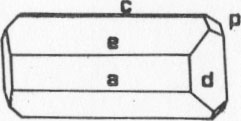| Home | AmMin | GMR | RiMG | Collectors Corner | Directory | Short Courses | |
|
|
|||||||

|
|
Volume 48, pages 421-422, 1963 CRYSTALS OF RAMMELSBERGITE AND ALGODONITE SIDNEY A. WILLIAMS, Department of Geology, Michigan College of Mining and Technology, Houghton, Michigan. Several occurrences of copper and nickel arsenides in the Michigan copper district have been brought to light and studied by various workers within the past year. Species such as rammelsbergite, pararammelsbergite, niccolite and maucherite have been reported along with new finds of domeykite and algodonite. Unusual among these finds has been the discovery of crystals of rammelsbergite and algodonite. A specimen given to the writer by a student, Robert H. Dean, contained a dozen rough but measurable crystals of rammelsbergite about 1 mm in size. The crystals were associated with α-domeykite and niccolite plus trichalcite, annabergite and gypsum as alteration products. The specimen came from Mohawk, Michigan, and the occurrence has been informally described by Moore (1962).
A crystal selected for measurement showed the following forms: c {001}, a {100}, d (230}, p {011}, and e {101}. Some other small, rough faces were noted but could not be located accurately enough to justify indexing. The indexing was accomplished using the axes of Buerger (1937); a 6.35, b 4.86, c 2.90 (Å). The identity of the crystals as rammelsbergite was established with an x-ray powder pattern, and grain size measurements indicated that the crystals were not pseudomorphs. A drawing of the crystal is shown in Fig. 1. Copper arsenide specimens found recently at Painesdale, Michigan proved to contain excellent crystals of algodonite. The crystals are very sharp but commonly are fantastically distorted, making orientation difficult. Many crystals occur as parallel overgrowths on ill-formed crystals of arsenian copper. Since the algodonite crystals are soft and metallic, great difficulty was experienced in prying loose crystals without deforming them.
An excellent crystal selected for measurement showed the following forms:
c {0001}, m {10 The masses of arsenides in which the algodonite occurs are rich in copper near the matrix, and the arsenic content appears to increase in the centers of the masses. The good crystals line pockets in the arsenides; algodonite is interstitial to quartz and calcite and so does not form well developed crystals in the matrix. REFERENCES BUERGER, M. J. (1937) A common orientation and a classification for crystals based upon a marcasite-like packing. Am. Mineral. 22, 48. MOORE, P. B. (1962) Copper arsenides at Mohawk, Michigan. Rocks and Minerals. 37, 24.
|
